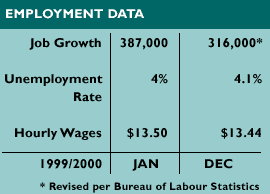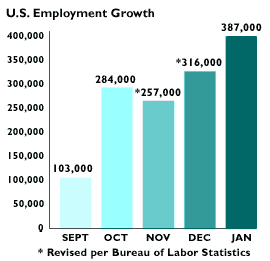|
Jobs surge, wages stable
|
 |
February 4, 2000: 1:18 p.m. ET
387,000 new jobs created in January; jobless rate at 4%, wages up 6 cents
By Staff Writer M. Corey Goldman
|
NEW YORK (CNNfn) - U.S. companies generated new jobs at the fastest pace in more than two years in January, and wages rose slightly faster than expected - the latest signs of a white-hot economy that may spur the Federal Reserve to raise interest rates again to ward off inflation.
The jobless rate fell to 4 percent last month, the Labor Department said Friday - the lowest since January 1970 - from 4.1 percent in December.
The economy created 387,000 jobs last month, well above forecasts of a 270,000 gain and the largest increase since September 1997. Average hourly wages -- a closely watched harbinger of inflation -- jumped 6 cents to $13.50 an hour, a larger-than-expected gain of 0.4 percent.
"It's obvious that the U.S. economy is very strong and producing jobs at a very robust pace," said Rob Palombi, a senior markets analyst with Standard & Poor's MMS in Toronto. "Even with the relatively tame wage gains, the market is anticipating another interest rate increase from the Fed."
Inflation-sensitive bonds extended losses once the numbers were sifted through and interpreted, while stocks posted mixed results, with the Dow Jones industrial average giving back early gains.
Concern about inflation
Wall Street economists and Fed officials, including Chairman Alan Greenspan, have expressed concern lately about the robust U.S. job market, which has led to a shrinking pool of workers available to produce the surging quantity of goods and services U.S. consumers demand.
 Indeed, at a time when "pre-IPO" has become common verbiage in job Indeed, at a time when "pre-IPO" has become common verbiage in job
Descriptions, and companies are offering perks ranging from free gym memberships to sports cars to entice skilled workers, investors and some policy-makers are concerned that wages eventually will start to accelerate.
That concern put the seal on what many analysts and investors already had anticipated -- that the Fed likely will raise interest rates again in March in a bid to slow the economy and ward off inflation. The Fed Wednesday lifted short-term rates for the fourth time in seven months, making borrowing for consumers and businesses more expensive. The Fed funds rate -- the target rate commercial banks charge each other for overnight loans -- is now 5.75 percent.
Higher wages can lead to inflation as companies pass their higher costs on to consumers in the form of price increases. But some economists and policy-makers say the growing use of computers, the Internet and other technology has allowed workers to produce more per hour, allowing companies to hold the line on prices, thus keeping a lid on inflation.
Warm weather factors
Labor Secretary Alexis Herman told CNNfn she wasn't concerned so much with a labor shortage as a skill shortage. She noted that as many as 10 million workers are ready and willing to take on a job if they could get access to transportation and childcare, and as many as 3 million are working part-time positions and would like to move to full time.
Herman also pointed to seasonal factors that distorted January's large increase in job creation, including a 116,000-worker surge in construction. That came from unseasonably warm weather that allowed builders to keep digging and building at a time of year when they normally would cease, she said. (542KB WAV) (542KB AIFF)
President Clinton reiterated Herman's positive outlook, calling the numbers a milestone of the U.S. economy's record expansion. On Monday, the economy entered its 107th month of uninterrupted growth, surpassing the previous record of 106 consecutive months of expansion posted in the 1960s.
For the month, service-producing employment increased by 256,000, a result of companies retaining seasonal employees beyond the traditional busy holiday season. Manufacturing gained 13,000 positions, reflecting strong demand for American-made goods and workers needed to produce them. The government Thursday reported that orders at U.S. factories surged to the highest pace in seven years in December.
Government hiring spree
Government employment also rose last month, bolstered by a hiring spree at the U.S. Census Bureau. The bureau is looking to hire a minimum of 500,000 new employees by April to help carry out its Year 2000 population count, which started Jan. 20. The Labor Department said 11,000 temporary positions were added in January for the Census Bureau's population count.
 To Main Street, the stellar job creation is more great news. Not since the 1960s has so large a percentage of Americans had jobs -- and a choice of positions, to boot. Demand for labor in services, retail and technology, among other industries, has generated more jobs than the number of workers available to fill them, making it a buyer's market for job seekers. To Main Street, the stellar job creation is more great news. Not since the 1960s has so large a percentage of Americans had jobs -- and a choice of positions, to boot. Demand for labor in services, retail and technology, among other industries, has generated more jobs than the number of workers available to fill them, making it a buyer's market for job seekers.
However, good news is often bad news on Wall Street, particularly when it comes to job creation. With so many people in America working, the chances of workers demanding higher wages is significant enough to prompt more rate increases, even with inflation practically non-existent, according to Bruce Steinberg, chief economist with Merrill Lynch.
The numbers "guarantee that the Fed has more tightening to go," Steinberg said. "We'll probably see the jobless rate go below 4 percent in the coming months. If by the middle of the year we're still seeing jobs growing at the kind of pace we're seeing, there will still be still more tightening."
Higher rates coming
Steinberg anticipates the Fed will lift rates another quarter point at its March 21st meeting, and at least another additional quarter point at its May 16 session, unless the economy begins to exhibit signs of slowing.
As usual, the numbers did not mean the same thing to all people. For some, 300,000-plus job creation actually suggests the labor market may not be as stretched as some analysts and Fed officials have suggested.
"The labor force surge should serve as a reminder that the economy is further from running out of labor than the economists at the Fed think," said John Ryding, senior economist with Bear Stearns. "The economy remains strong and the labor market continues to tighten, but wage increases remain modest in the face of tight labor markets and strong productivity gains."
That's why all eyes will be on next week's report from the Labor Department on fourth-quarter productivity gains, due for release Tuesday morning. Analysts polled by Reuters expect productivity gained 3.7 percent in the fourth quarter, slower than the 4.9 percent surge recorded in the third. 
|
|
|
|
|
 |

|

